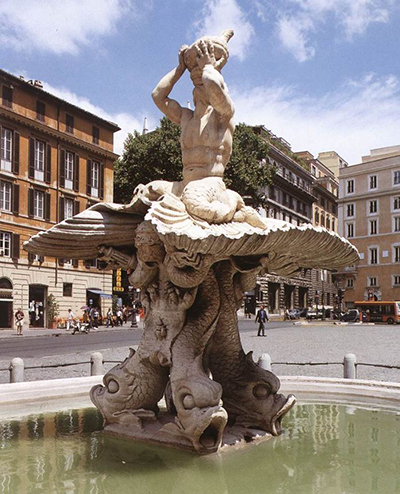Fontana del Tritone, a 17th-century fountain by Gian Lorenzo Bernini, was commissioned by Pope Urban VIII, who was his patron.
The fountain is located in Rome, in the Piazza Barberini, close to the Palazzo Barberini entrance, which now houses the GNAA (Galleria Nazionale d'Arte Antica or National Gallery of Ancient Art), that the sculptor Bernini helped to design as well as build for the Barberini, the family of Urban. Fontana del Tritone should be distinguished from Carlo Francesco Bizzaccheri’s Fountain of the Tritons (Fontana dei Tritoni) in Piazza Bocca della Verità and features 2 Tritons.
This is the first of free-standing urban fountains by Bernini, and it was constructed to mainly provide water from one of the aqueducts of Rome, Acqua Felice, a dramatic celebration that Urban had restored. This was the last major commission that Bernini got from Pope Urban VIII who died in the year 1644. At this fountain, Bernini and Urban brought the sculptural fountain idea, familiar from villa gardens, and decisively for the first time, to a public urban setting. Before, public fountains in Rome were passive basins used for the reception water for the public.
This fountain was executed in 1642 to 1643 in travertine. At the centre of the fountain rises a muscular Triton that’s larger than lifesize, a minor ancient Greco-Roman legend sea god, depicted as a merman who kneels on the sum of 4 dolphin tailfins. The arms of the Triton raise a conch to the lips and his head is seen thrown back. A jet of water often spurts from the conch, previously raising dramatically higher compared to how it does nowadays. Fontana del Tritone has a base of 4 dolphins entwining the papal tiara (a crown that popes used to wear) with crossed keys as well as the heraldic Barberini bees seen in their scaly tails.
The Triton Fountain is among the ones that were evoked in the Fontane di Roma by the Italian musicologist, composer and violinist known as Ottorino Respighi. The legend that was applied to Ottorino Respighi was extended to this: any visitor who will throw his coin into the water (facing away from this fountain), they will guarantee their return to Rome.
Since the 17th century, the Piazza Barberini’s setting has changed significantly. Photographs from the 19th century and engravings of the time show buildings that were much lower around the piazza, which could have made this fountain more dramatic. However, it’s a tribute to Bernini’s artistic judgment that even today, with tall buildings seen around the traffic-ridden piazza, the fountain can still manage to maintain a dramatic presence.
Bernini represented the triton to show Ovid's Metamorphoses book I triumphant passage, and he evokes godly control over the waters as well as describes the Universal Deluge’s draining away. The passage Urban set Bernini to exemplify was recognised by literate Roman contemporaries. Two finished terracotta bozzetti located at the DIA (Detroit Institute of Arts) in Midtown Detroit, Michigan, securely attributed to Gian Lorenzo Bernini, reflect his fountain's themes exploration of the 4 intertwined upended dolphins plus the scaly-tailed, muscular Triton.




